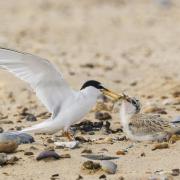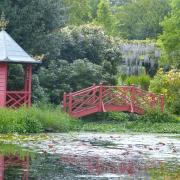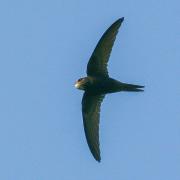Winter’s cold can make us want to hibernate under a blanket with our favourite boxset or a good book. But February brings the promise of spring, as nature starts to gradually awaken. Clumps of crisp white snowdrops pop up in our gardens and vibrant purple and yellow crocus say a cheery hello. Wrapping up warm against the bracing cold to step out and connect with the outdoors at this time of year is definitely worth the effort, as there is much to love about nature and the benefits it can bring you during February.
If you take the time to connect with nature this month, you will reap huge rewards. Nature is good for you, in mind, body and soul, as individuals with a greater connection to nature experience improved mental wellbeing, greater vitality and happiness, and are generally more satisfied with life. Hugely important during the dark days of winter! Research also shows that increasing your connection with nature can positively impact a range of conditions, including stress, anxiety and depression. Doesn’t it just make you love nature even more?

So, open up your eyes and ears to embrace nature in Suffolk this month – look for bustling Blue Tits investigating places to nest with their mate in the spring, listen for Great Spotted Woodpeckers starting to ‘drum’ on trees making it known they are here and ‘available’ to a potential mate, and look and listen for frolicking frogs in ponds who, during the latter stages of winter when temperatures start to lift slightly, can emerge and start spawning.
Not sure where to start to make that love of nature connection? Gardens, local parks or countryside walks are wonderful places to get started. Or if you fancy making a whole day out of it and going for a nature filled walk, RSPB nature reserves are just waiting there for you to discover, and the good news is that Suffolk has more than its fair share.
Here’s what RSPB Minsmere on the Suffolk coast and RSPB Lakenheath Fen in the west of the county have to offer on their nature trails:

RSPB Minsmere
The Coast Trail (two miles) offers a full sensory experience. Pause to take in the sounds of nature; wind whistling through the reeds, the pinging call of Bearded Tits or the strident song of a Cetti’s Warbler that stubbornly remains hidden from view. Taste the salt in the air as the waves crash onto the shore. Take time out in the hides and indulge in a spot of birdwatching. How many different ducks can you spot? Will you find Minsmere’s star species, the Avocet?

As you stroll through the woods on the Island Mere Trail (1.5 miles), look for clusters of Hazel catkins dangling from the branches, or listen to twittering flocks of Siskins and Goldfinches feeding on the Alder tree cones above your head. Climb the 32 stairs into Bittern Hide for amazing views across the reedbed. Sit patiently here, or in the impressive Island Mere Hide, and wait for the wildlife to appear. Will a Bittern stalk stealthily into view, a Marsh Harrier glide past, or an Otter swim by?

For something a bit different, or if you have a dog for company (on a lead, please), why not explore the public footpaths that cross Minsmere’s varied habitats? Take in the vast open heathlands and wonderful woodlands between Westleton and Dunwich in search of Dartford warblers, woodpeckers or flocks of finches. Feel the crunch of sand and shingle beneath your feet as you gaze across the vast wetlands from the dunes. Take a detour from the Sluice to explore the ruins of Leiston Abbey, rising above the marsh, then return to the start via a footpath to the pretty hamlet of Eastbridge.

RSPB Lakenheath Fen
The Brandon Fen Family Trail ( approx 1.5 – 2.5 mile route) weaves through blocks of Poplar trees that support a variety of woodland birds including Marsh Tit, Long-tailed Tit and the elusive Treecreeper. Look out for Goldcrest, Siskin, Lesser Redpoll and Brambling, as well as larger songbirds such as Redwing and Fieldfare during winter months. These last two birds are members of the thrush family and you may either see them perched high in the trees or looking for worms and bugs in the leaf litter below. Kestrel and Sparrowhawk frequent the woods and occasionally a Barn Owl is spotted, especially at dawn and dusk.

A circular 1.5 mile route, the East Wood Trail offers a good range of different habitats. Walking past East Wood to New Fen Viewpoint, it’s worth pausing here to watch the pool and the reedbed behind. Kingfisher, Great White Egret, Little Grebe and a variety of ducks including Gadwall and Shoveler are often seen enjoying the pool and reedbed. As February moves on and gives way to spring, there is the chance of one or more Common Cranes flying past, as well as plenty of Hobbies (we can have up to 60 on the reserve by the second half of May!). You may also be fortunate enough to hear booming Bitterns. You’ll follow a cut path through a rough meadow next, which is a great place for visitors interested in insects and wildflowers during warmer times of year. The Photography Station is on this route and the feeders there attract a variety of farmland and garden birds including Great Spotted Woodpecker and Water Rail in the colder months.

The 3 mile Long Circular Trail passes the Mere Hide and is worth a look for Kingfisher and Bittern all year round, Bearded Tits in the winter and Common Tern and Great Crested Grebe in warmer months. Walk past our largest woodland, West Wood, which has attracted breeding Nightingale in recent years. The viewpoint on this walk is a hotspot for Bearded Tit. Listen for their ‘pinging’ calls as small groups pass over the reedbeds. In the winter they feed on reed seeds in the reedbed which can make them easier to see, as they spend more time at the tops of the reeds. From the viewpoint at Joist Fen, expansive views in winter make this an ideal spot at dusk as Marsh Harrier fly in to roost. You may also see Hen Harrier, Sparrowhawk, Merlin or Peregrine Falcon at the same time. The route back leads you to the riverbank and with luck you will hopefully spot even more of the wonderful wildlife on your walk back.
The RSPB has 10 Suffolk nature reserves that are open at this time of year for your enjoyment. You can find out more about them, including RSPB Minsmere and Lakenheath Fen, here: bit.ly/RSPBSuffolk



























